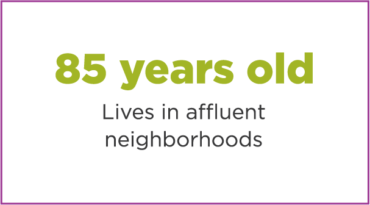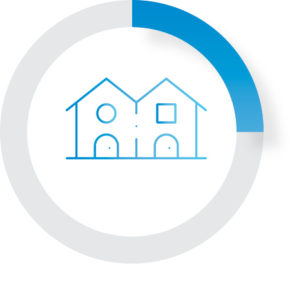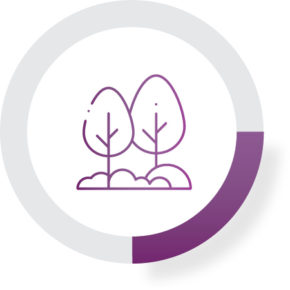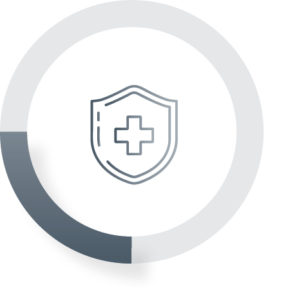Where You Live Counts
The life expectancy of those living in disadvantaged areas of Erie, Pennsylvania, is 68 years old, compared to 85 years old for those living in affluent neighborhoods.


Social Determinants of Health
Why it Matters
Social determinants of health are the conditions in the environments where people are born, live, learn, work, play, worship, and age that affect a range of health outcomes, including incidences of chronic disease, mortality, and life expectancy.
Income, education, transportation, food and housing security, employment, neighborhood safety, and access to health care all impact a person’s health.
By the Numbers
People living in disadvantaged neighborhoods have a 40%-70% higher risk for coronary heart disease than their counterparts in advantaged neighborhoods.
Substandard housing contributes to 1,000,000 children in the U.S. suffering from blood lead levels high enough to adversely affect their intelligence, behavior, and development.1
All-cause mortality in low-income census tracts is about 30% higher than in high-income census tracts.
Localized Disparities

A 360° Approach to Overcome Disparities
While these disparities are disheartening, there is hope. Hamot Health Foundation has a vision. By providing the essential building blocks for a healthy and prosperous life — education and workforce training, neighborhood development, housing, and access to trusted health care — we can reverse these alarming trends.

Education and Workforce Training
Why It Matters: Life- and family-sustaining wages promote economic security and mobility, which have been found to reduce stress and improve health.
What We’ve Done: Awarded $85,000 in scholarships annually to assist UPMC Hamot employees advance their careers through education. Helped stand up the Jameson School of Nursing at UPMC Hamot and training programs in Clinical Medical Assistant and trades education at The Erie Center for Arts and Technology (ECAT).
What’s Next: Career training programs in development include certified Central Sterile Processing and Freedom House at ECAT and an LPN program at the Erie County Community College. ECAT is also exploring culinary arts and medical billing training programs.

Housing
Why It Matters: Health begins at home. Poor housing quality contributes to poor health outcomes. Mold, lead, broken stairs, leaky roofs, poor ventilation, and unsafe heating elements must be addressed to improve health and prevent harm. Housing instability is correlated to decreased access to routine health care as well as increased stress, depression, anxiety, and ED utilization. Homelessness is associated with increased risk for cardiovascular disease morbidity and mortality, obesity, and diabetes.2
What We’ve Done: HHF serves in a leadership role on Erie’s Permanent Supportive Housing project team, aiming to eradicate homelessness in the city. HHF recently submitted a $1 million grant application for addressing housing in Erie.
What’s Next: HHF will remediate abandoned lots, renovate homes, and provide pathways to homeownership. Throughout the city, HHF and its partners will initiate this work in the most disadvantaged neighborhoods.

Neighborhood Development
Why It Matters: Environment shapes behavior and impacts health. Blight remediation leads to reduced firearm violence, improved mental health, and lower stress. Participation in social events increases sense of empowerment, individual coping ability, and improves health behaviors.
What We’ve Done: HHF has listened to our neighbors about their hopes, dreams, and needs through two community surveys. We’ve invested in anchor institutions like ECAT at Wayne School as well as blight removal and beautification projects.
What’s Next: HHF will focus on addressing the unmet needs identified through the surveys: better lighting, blight remediation, less litter, safer crosswalks, street beautification, community events that promote social connection and access to more businesses and services in underserved neighborhoods.

Access to Trusted Health Care
Why It Matters: Barriers to care such as access and transportation can cause individuals to forego care. Preventative and primary medical care are essential to leading a healthful life.
What We’ve Done: HHF has established Wayne Primary Care
and the Women’s Recovery Center. Two health insurance enrollment navigators joined the team to support uninsured individuals during enrollment.
What’s Next: HHF will collaborate with partners to create neighborhood centers in the Wayne District and other disinvested areas in Erie. These centers will unlock access to primary and specialty care through telemedicine by erasing access barriers.

The numbers don’t lie. Support will add up and you will make the difference.
Can we count you in?
1Housing and Health: Time Again for Public Health Action | AJPH | Vol. 92 Issue 5 (aphapublications.org)
2 Housing instability and cardiometabolic health in the United States: a narrative review of the literature | BMC Public Health | Full Text (biomedcentral.com)

